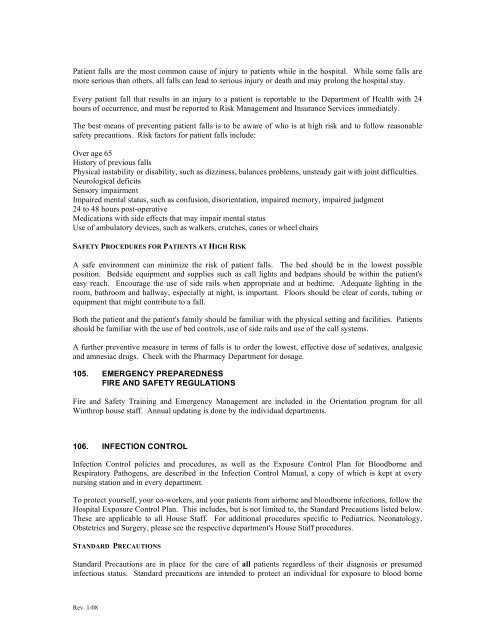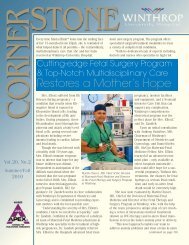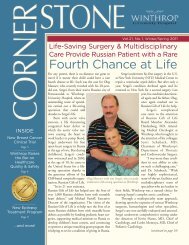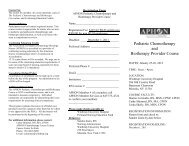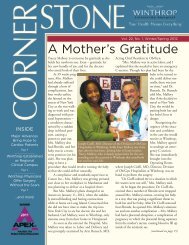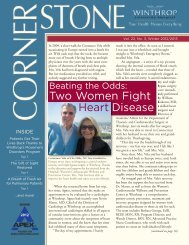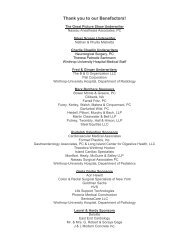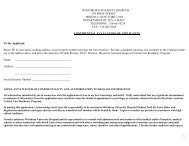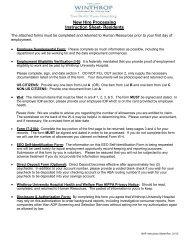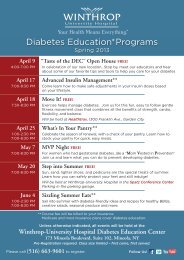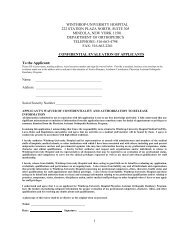House Staff Manual - Winthrop University Hospital
House Staff Manual - Winthrop University Hospital
House Staff Manual - Winthrop University Hospital
You also want an ePaper? Increase the reach of your titles
YUMPU automatically turns print PDFs into web optimized ePapers that Google loves.
Patient falls are the most common cause of injury to patients while in the hospital. While some falls aremore serious than others, all falls can lead to serious injury or death and may prolong the hospital stay.Every patient fall that results in an injury to a patient is reportable to the Department of Health with 24hours of occurrence, and must be reported to Risk Management and Insurance Services immediately.The best means of preventing patient falls is to be aware of who is at high risk and to follow reasonablesafety precautions. Risk factors for patient falls include:Over age 65History of previous fallsPhysical instability or disability, such as dizziness, balances problems, unsteady gait with joint difficulties.Neurological deficitsSensory impairmentImpaired mental status, such as confusion, disorientation, impaired memory, impaired judgment24 to 48 hours post-operativeMedications with side effects that may impair mental statusUse of ambulatory devices, such as walkers, crutches, canes or wheel chairsSAFETY PROCEDURES FOR PATIENTS AT HIGH RISKA safe environment can minimize the risk of patient falls. The bed should be in the lowest possibleposition. Bedside equipment and supplies such as call lights and bedpans should be within the patient'seasy reach. Encourage the use of side rails when appropriate and at bedtime. Adequate lighting in theroom, bathroom and hallway, especially at night, is important. Floors should be clear of cords, tubing orequipment that might contribute to a fall.Both the patient and the patient's family should be familiar with the physical setting and facilities. Patientsshould be familiar with the use of bed controls, use of side rails and use of the call systems.A further preventive measure in terms of falls is to order the lowest, effective dose of sedatives, analgesicand amnesiac drugs. Check with the Pharmacy Department for dosage.105. EMERGENCY PREPAREDNESSFIRE AND SAFETY REGULATIONSFire and Safety Training and Emergency Management are included in the Orientation program for all<strong>Winthrop</strong> house staff. Annual updating is done by the individual departments.106. INFECTION CONTROLInfection Control policies and procedures, as well as the Exposure Control Plan for Bloodborne andRespiratory Pathogens, are described in the Infection Control <strong>Manual</strong>, a copy of which is kept at everynursing station and in every department.To protect yourself, your co-workers, and your patients from airborne and bloodborne infections, follow the<strong>Hospital</strong> Exposure Control Plan. This includes, but is not limited to, the Standard Precautions listed below.These are applicable to all <strong>House</strong> <strong>Staff</strong>. For additional procedures specific to Pediatrics, Neonatology,Obstetrics and Surgery, please see the respective department's <strong>House</strong> <strong>Staff</strong> procedures.STANDARD PRECAUTIONSStandard Precautions are in place for the care of all patients regardless of their diagnosis or presumedinfectious status. Standard precautions are intended to protect an individual for exposure to blood borneRev. 1/08


